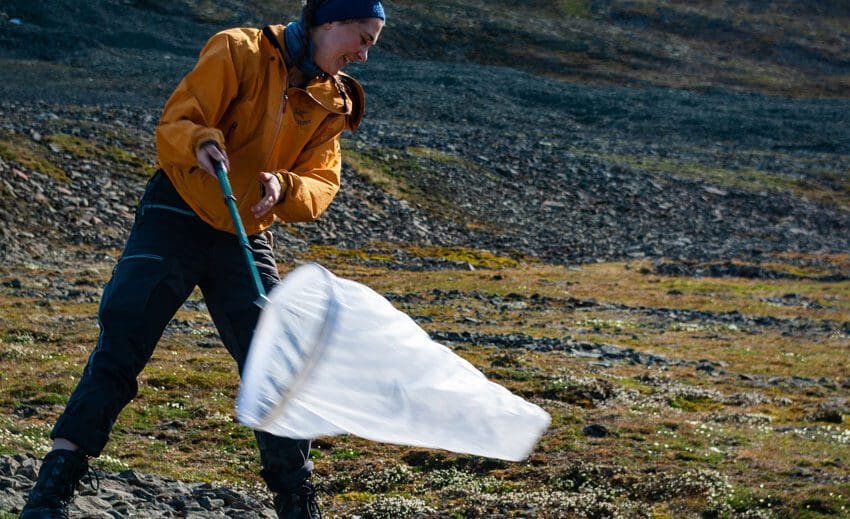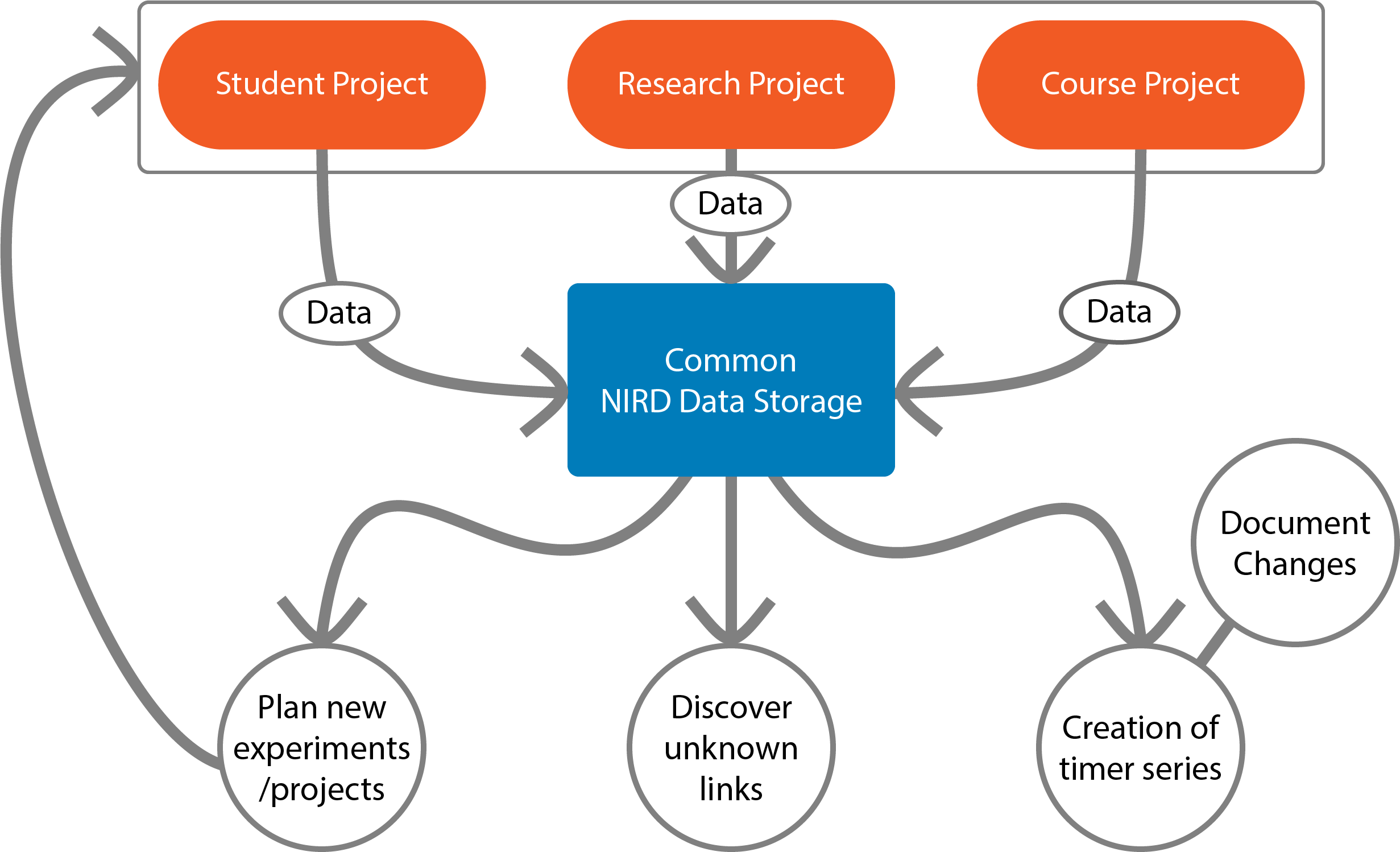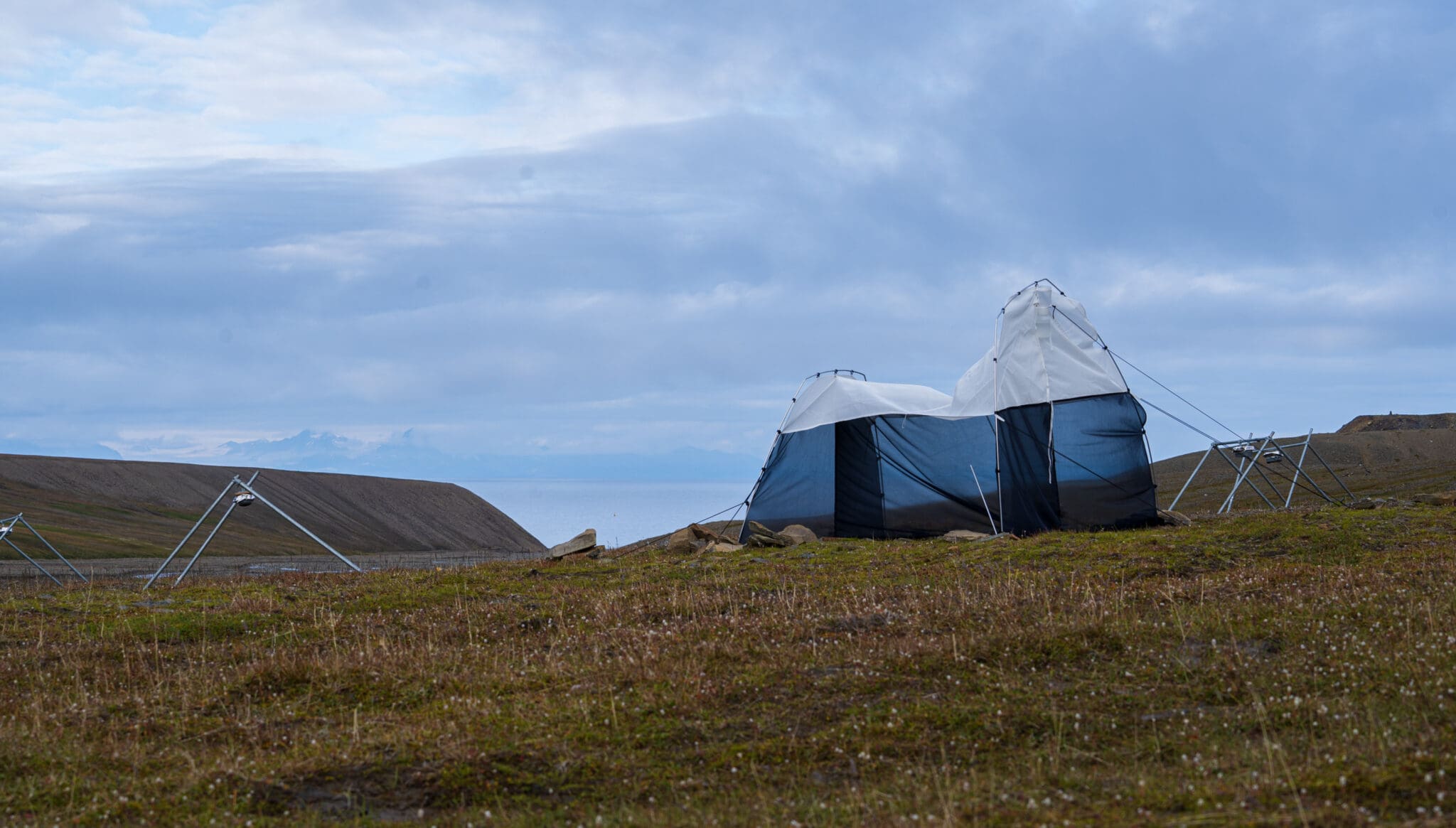Bjørndalen Integrated Gradients (BIG)
Bjørndalen Integrated Gradient (BIG) is a field-laboratory that enables close integration of research and course activities, and a great arena for students to participate and contribute to research projects.
active

Rebekka Ween hunts pollinating insects with a sweep net. Photo: Simen Hjelle
About the project
BIG was established in 2019 by the Department of Arctic Biology (AB) at UNIS, supported by funding from the Olav Thon Foundation and internal allocations. BIG is a strategic platform integrating biological research, learning and monitoring within and across the terrestrial, benthic and marine habitats at one location in high-arctic Svalbard.
Strategically, BIG will provide unique knowledge and education necessary for an integrated understanding of how the Arctic terrestrial, benthic and marine ecosystem are structured and functions under long-term environmental and climatic changes. Currently, BIG consists of several research projects along the Bjørndalen Integraded Gradient, including long-term marine time-series (IsA), multiseasonal of flower phenology and pollination activity interactions, seasonal capture of invertebrates at weekly intervals and monitoring of reindeer spatial population dynamics.

Our field laboratory

A field laboratory will…
- Create cost-effective research synergy between faculty
- Give authentic research experiences for students
To succeed in this…
- Data must be available in a common storage
This will enable the possibilities of…
- Initiating inquiry-based student projects
- Invite external researchers to establish within a system where background knowledge exists
And give the outcome of…
- Piece by piece increase the overall knowledge of the study system
- Embrace interactions in the ecosystem as a whole
- Over time separate seasonal variations form climate change

Research projects
- Reindeer population dynamics
- BIG – Flower & invertebrate phenology time series
- Long-term monitoring of vegetation
- INITIAL – Going BIG: a spatial grid as basis for the Bjørndalen field laboratory
- Purple Saxifraga – A model system for speciation
Project resources
Weather Station
Data Templates
| Data Type | Method | Darwin Core (Y/N) | Blank | Example |
|---|---|---|---|---|
| Vegetation Registration/Description | Quadrat method | Y | .xlsx | .xlsx |
| Plant Trait Registration | List of Traits | Y | .xlsx | .xlsx |
| Feces Collection and Measurements | Y | .xlsx | .xlsx | |
| Reindeer Population | Y | .xlsx | .xlsx |
Protocols
| Description | Download |
|---|---|
| Reindeer counting | Click Here |
| Invertebrate sampling | Click Here |
| Purple saxifrage transect establishment | Click Here |
| Time lapse camera set-up | Click Here |
| Purple saxifrage flow cytometry | Click Here |
| Quadrate Sampling | Click Here |
Sampling Sheets
| Description | Download |
|---|---|
| Vegetation Analysis/Description | Click Here |
| Reindeer Counting Sampling Sheet | Click Here |
| Reindeer Counting Bjørndalen Sampling Map Sheet | Click Here |
| Saxifraga oppositifolia flower phenology – Bjørndalen River plot | Click Here |
| Saxifraga oppositifolia flower phenology – Bjørndalen Slope plot | Click Here |
| Saxifraga oppositifolia flower phenology – Bjørndalen Ridge plot | Click Here |
List of Existing Data
| Type of data | Method | Season | Time |
|---|---|---|---|
| Captured invertebrate | Capture via sweep net*, fall traps (x18), malaise traps (x2) | Summer | 2019-present |
| Reindeer population time series | Visual observations along path. Sex/Age and location registered | Feb-Oct | 2019-2022 |
| Silene Aculis phenology time series | Image capture from above plant (60cm) and 1 minute (to 1 hour) intervals (n = 10**) | Summer | 2019-2021 |
| Dryas Octopetala phenology time series | Image capture from above plant (60cm) and 1 minute (to 1 hour) intervals (n = 8) | Summer | 2019-2021 |
| Soil temperature/mositure | At several locations (~7), some also record soil moisture | All year | 2019-present |
| Vegetation analysis | Visual estimate of plant/soil cover within 60x60cm vegetation frame (Quadrat) | One time | 2021 |
| Snow melt time lapse | Photos taken from valley showing snow melt and other seasonal changes. Once per hour. | All year | 2019-2021 |
| Weather data (wind speeds, solar radiation, ground and air temperature, soil moisture) | Data collected from weather station located in Bjørndalen | All year | 2020-present |
| Registration of vegetation (monitoring) | Pin-point method, from 3 locations with 3 plots each | Summer (Biannually) | 2019-present |
| Manual soil mositure | Portable soil moisture meter, every other week | Summer | 2019 |
| Saxifraga oppositifolia flower stage and count | Manual check-up of registered plants, visual inspection. | Summer | 2019-2021 |
| Saxifraga oppositifolia ploidy level | Flow cytometry. | One time | 2019 |
| Pin-point vegetation analysis | From a large grid plot | Summer | 2023 |
People involved with the project
Pernille Bronken Eidesen / Project Leader 2019-2021
Steve Coulson / Project Leader 2021-
Mads C. Forchhammer / Project Member 2019-2021
Simone I. Lang / Project Member 2019-
Simen Salomonsen Hjelle / Fieldwork, Data Management 2019-2022
Tina Dahl / Fieldwork 2022
Timon Brüggemann / Fieldwork 2020
Sine Sara / Fieldwork 2020
Anne Bruls / Fieldwork 2019
Student thesis and research projects
Maria Huntstaar / Bachelor Thesis 2020-2021 & Master Thesis 2021-
Ida Christina Apalnes / AB-207 Research Project 2022
Ingrid Kleppe Normann / AB-207 Research Project 2022
Line Klaus / Master Thesis 2022-2022
Rebekka Ween / Master Thesis 2019-2022
Emma Limose Djurber / AB-207 Research Project 2021
Xenia Uffrecht / Internship (Funded by RECITE) 2021 & AB-207 Research Project 2021
Ingrid Vesterdal Tjessem / Master Thesis 2020-2021